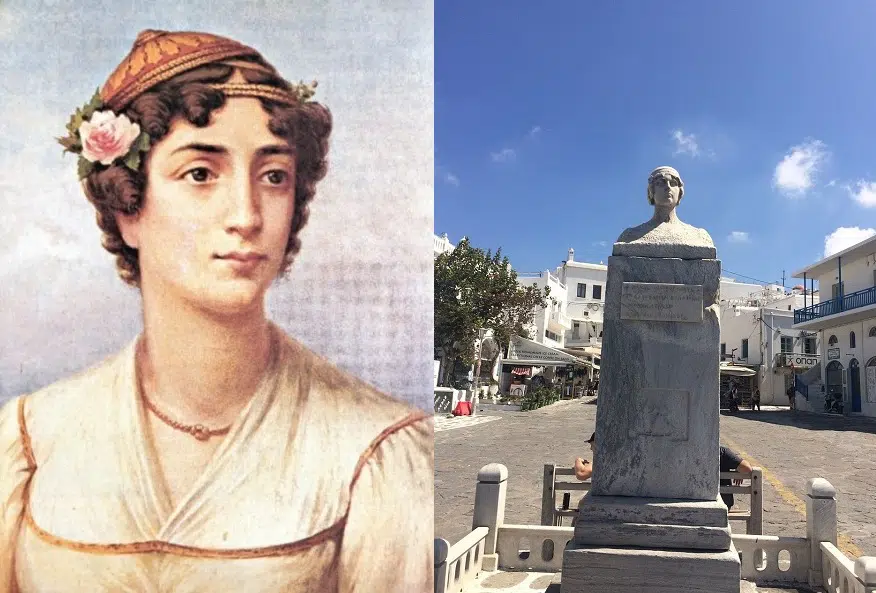
It was October 11, 1822 in the second year of Greece’s War of Independence, when the Ottomans, attempting to invade the island of Mykonos, were repelled by brave islanders fighting under the command of Manto Mavrogenous.
Now a place known for its many sandy beaches, as well as its seemingly endless array of glitzy nightclubs and bars for the jet set, it may be a bit difficult today to envision this idyllic holiday spot as the scene of a desperate battle between the Greeks and the Turks.
Ships from the Turkish-Egyptian Navy still dominated the Aegean at that time despite the individual triumphs of some Greek ships in a series of battles.
Instead of chasing the Turks in the Aegean and setting up ambushes with its artillery, the Greek fleet was forced to return to its bases because there was no money for its payroll, as evidenced by the letters of the Greek Navy commander Andreas Miaoulis to Greece’s Provisional Administration.
The Turkish fleet, for its part, sailed to Crete and docked at Souda after its failures at Spetses and Nafplion. Their ships departed on October 8, 1822 to spend the winter in Constantinople.
On Tuesday, October 11th, part of the Turkish fleet sailed between the islands of Naxos and Mykonos, and some vessels were observed approaching the coast of Mykonos. The islanders were already concerned about a possible invasion, but their fears were heightened when a Mykonos captain suddenly spied the Algerian flag flying from the ships through his telescope.
The Mykonians, like other Cyclades islanders, had suffered from many Algerian pirate raids over the years. They had also already fought the Turks themselves both at sea and on land.
They therefore determined that they would not let the enemy reach their homeland without stiff resistance.
When the alarm sounded across the island, all the residents of Mykonos gathered together at the port. Shortly afterward, enemy ships began launching smaller boats into the sea and approximately one hundred Algerian fighters landed on the shores of Mykonos.
It was believed that they had come to either feed their livestock or to punish the Mykonians at the behest of the Turks.
Headed by Manto Mavrogenous, Mykonos islanders repelled invaders
Headed by Mavrogenous—although some historians dispute her presence in the battle—the defenders fought the Algerian sailors bravely. Armed with short-range firearms, they repelled them, forcing most of them back onto their ships.
Seventeen Algerians breathed their last breaths on Mykonos island and many more were wounded in the fracas. Turkish ships then began bombarding the port but without success.
Two ships belonging to the Greek forces, which had been equipped by Mavrogenous, were crucial in harrying the Turks during this ferocious battle.
The ruler, Kapudan Pasha, then decided that it may not be worth his time trying to invade the island. After withdrawing and anchoring his ships in the area between Naxos and Mykonos, he ordered the fleet to sail northward to Constantinople on October 14th.
Manto Mavrogenous
Born in 1796 in Trieste, Italy, which was part of the Austrian Empire at the time, Mavrogenous moved to Paros with her family in 1809. She joined the secret revolutionary organization “Filiki Etairia” in 1820 after she learned from her father, who was already a member of the organization, that they were preparing an open rebellion against the Turks.
A wealthy and well-educated woman, Mavrogenous was able to convince her well-off European friends to donate large amounts of money for the purchase of ships, armaments, and ammunition for the Greek side. The Greek independence leader even traveled as far as Paris to appeal to wealthy women to side with the Greeks in their desperate bid for freedom.
Mavrogenous first traveled to Mykonos with the purpose of inviting local leaders there to join in the revolution. In 1823, she moved to Nafplio to fight at the very center of the War of Independence, later assembling other fleets of ships that fought in the battle of Karystos.
Staying on in Nafplion after the liberation, the female icon of the Greek independence movement was later granted the rank of Lieutenant General by the first governor of Greece, Ioannis Kapodistrias.
Mavrogenous is remembered today as one of the few females in the world who have openly fought in military conflicts in modern times. She not only made it possible for Greek forces to continue fighting by raising the necessary funds for them, but she also served as a galvanizing figure who could personally lead the troops in the most crucial battles of the war.
After Kapodistrias’ assassination, Mavrogenous eventually went to live on the island of Paros, where she tragically spent her last years in a state of destitution. Greece’s brave female fighter in the great struggle for independence succumbed to typhoid fever in July of 1848, having spent her entire fortune in the fight to create a new Greek nation.
See all the latest news from Greece and the world at Greekreporter.com. Contact our newsroom to report an update or send your story, photos and videos. Follow GR on Google News and subscribe here to our daily email!



